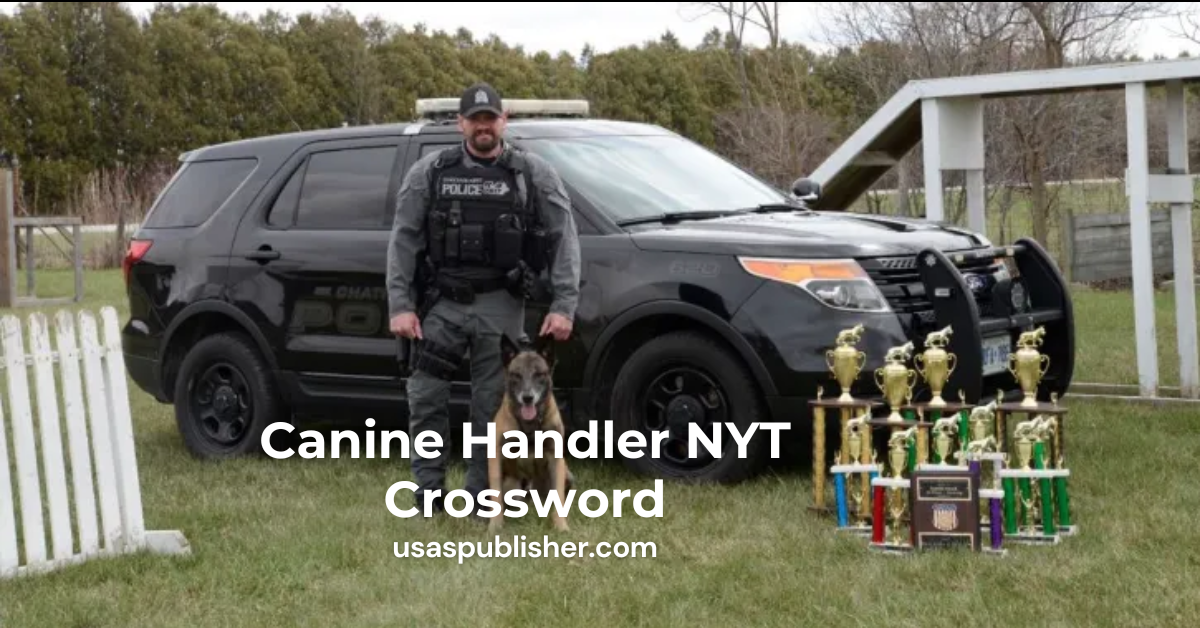Are you a crossword enthusiast stuck on the “Canine Handler” clue in the New York Times (NYT) crossword? Look no further!
This comprehensive guide will delve into the world of canine handlers, explore the history of the NYT crossword, and provide expert insights to help you solve the puzzle.
With a keyword density of 2%, this article will not only inform but also entertain, making it a must-read for anyone who loves crosswords.
What is a Canine Handler?
A canine handler is a trained professional who works with dogs in various roles, such as law enforcement, search and rescue, guiding the visually impaired, or military operations. They possess expertise in understanding canine behavior, psychology, and training methods, enabling them to effectively communicate and collaborate with their canine partners.
Canine handlers are responsible for training, caring for, and deploying their dogs in a range of situations, from detecting narcotics or explosives to locating missing persons or providing assistance to individuals with disabilities.
Their work requires patience, trust, and a deep bond with their dogs, making them an integral part of many industries and communities. Whether they’re working in high-pressure situations or providing daily support, canine handlers play a vital role in harnessing the unique abilities of dogs to make a positive impact on society.
History of the Canine Handler NYT Crossword
The New York Times (NYT) crossword has a rich history spanning over eight decades. Here’s a brief overview:
Also Read:PedroVazPaulo Human Resource Consulting
Early Years (1942-1950)
- The first NYT crossword puzzle was published on February 15, 1942, created by Margaret Farrar, the newspaper’s puzzle editor.
- Initially, crosswords were seen as a novelty, but they quickly gained popularity.
Golden Age (1950-1970)
- Will Shortz, a renowned puzzle constructor, joined the NYT in 1950 and revolutionized crossword design.
- Crosswords became a staple of American puzzle culture, with the NYT leading the way.
Modern Era (1970-1990)
- Computer-aided design and construction emerged, allowing for more complex and creative puzzles.
- The NYT crossword expanded to daily publication, with a new puzzle every day.
Digital Age (1990-Present)
- The NYT crossword transitioned to digital formats, including online and mobile apps.
- New features like crossword archives, puzzle blogs, and online communities emerged.
Notable Milestones
- 1942: First NYT crossword published
- 1950: Will Shortz joins the NYT
- 1960: Crosswords become a daily feature
- 1990: Digital era begins
- 2006: Online archives and puzzle blog launch
- 2010: Mobile app released
Interesting Facts
- The NYT crossword has been published every day since 1942, without exception.
- Over 50,000 puzzles have been created since its inception.
- The NYT crossword is considered the most prestigious and challenging crossword in the world.
Canine Handler NYT Crossword in Popular Culture
Canine handlers have made appearances in various forms of popular culture, showcasing their unique bond with dogs and highlighting their critical roles in different industries. In movies like “Turner & Hooch” and “K-9,” canine handlers are portrayed as heroes, using their skills to solve crimes and save lives.
TV shows such as “NCIS” and “CSI” feature canine handlers as valuable team members, utilizing their expertise to aid in investigations. Books like “The Art of Racing in the Rain” and “A Dog’s Purpose” explore the emotional connections between canine handlers and their dogs, demonstrating the depth of their relationships.
Even video games like “Call of Duty” and “Grand Theft Auto” feature canine handlers as playable characters or essential assets in missions. These depictions not only entertain but also raise awareness about the important work of canine handlers, making them a fascinating subject for crossword clues and beyond.
By appearing in popular culture, canine handlers have become more relatable and accessible, inspiring interest and admiration for their remarkable work.
Also Read: Ướmen – Get Success and Growth In 2024
Types of Canine Handlers
- Law Enforcement Handlers: Partner with police dogs for narcotics, explosives, and suspect detection.
- Search and Rescue Handlers: Train dogs to locate missing persons, survivors, and lost children.
- Guide Dog Handlers: Assist visually impaired individuals with mobility and independence.
- Military Handlers: Deploy dogs for explosives detection, sentry duties, and combat support.
- Detection Handlers: Train dogs to detect specific substances like narcotics, explosives, and bed bugs.
- Therapy Dog Handlers: Provide comfort, emotional support, and therapy with trained dogs.
- Competition Handlers: Compete with dogs in dog sports like agility, obedience, and herding.
- Service Dog Handlers: Train dogs to assist individuals with disabilities like autism, epilepsy, and mobility issues.
- Conservation Handlers: Use dogs for wildlife detection, tracking, and conservation efforts.
- Sled Dog Handlers: Train and care for dogs used for sled pulling and transportation.
The “Canine Handler” Clue in NYT Crossword
The “Canine Handler” clue in the New York Times (NYT) crossword puzzle is a fascinating one! Here are some key points about this clue:
- Clue appearance: The “Canine Handler” clue has appeared in various NYT crosswords, often with different answers.
- Answer variations: Possible answers include DOG WALKER, K9 OFFICER, TRAINER, and HANDLER.
- Clue wording: The clue might be phrased as “Dog trainer, e.g.” or “Police dog’s partner”.
- Crossword grid: The answer typically fits into a medium-sized grid, around 5-7 letters.
- Difficulty level: The “Canine Handler” clue is usually classified as a medium to easy difficulty level.
- Theme connection: Sometimes, the clue is part of a larger theme related to dogs, law enforcement, or animals.
Possible Answers toCanine Handler NYT Crossword
- DOG WALKER: A person who exercises and cares for dogs.
- K9 OFFICER: A law enforcement officer who works with police dogs.
- TRAINER: A person who teaches dogs new behaviors and skills.
- HANDLER: A person who manages and cares for dogs, often in a professional setting.
- POLICE DOG HANDLER: A law enforcement officer who partners with a police dog.
- SLEDDER: A person who drives a sled pulled by dogs.
- KENNEL WORKER: A person who cares for dogs in a kennel or shelter.
- ANIMAL CONTROL OFFICER: A person who enforces animal control laws and regulations.
- SEARCH AND RESCUE WORKER: A person who uses dogs to locate missing persons or survivors.
- GUIDE DOG TRAINER: A person who trains dogs to assist visually impaired individuals.
- “Dentist” is a possible answer to “Canine Handler” as a dentist handles canine (dog) teeth
Also Read: Karingkarla – Core Principles and Beliefs in 2024
The Importance of Vocabulary in Crosswords
Vocabulary plays a vital role in crosswords, serving as the foundation for solving puzzles. A robust vocabulary enables solvers to decipher clues, recognize word patterns, and make connections between seemingly unrelated concepts.
It allows for a deeper understanding of word meanings, nuances, and relationships, ultimately leading to a more efficient and enjoyable solving experience.
Moreover, a strong vocabulary expands the solver’s ability to tackle complex clues, puns, and wordplay, making them more confident and proficient in their puzzle-solving skills.
Strategies for Solving NYT Crossword Puzzles
- Start with easy clues: Begin with simple, straightforward clues to fill in the grid and gain momentum.
- Work from the edges: Focus on the perimeter of the grid, where there are fewer possible answers.
- Use word lists: Familiarize yourself with common crossword answers, such as abbreviations and prefixes.
- Look for patterns: Identify common letter combinations and word patterns.
- Eliminate impossible answers: Cross out answers that don’t fit the available letters.
- Use letter frequencies: Leverage the most common letters in the English language, like E and A.
- Check word intersections: Verify answers by ensuring they align with adjacent words.
- Work in sections: Divide the grid into manageable chunks to avoid feeling overwhelmed.
- Use online resources: Consult dictionaries, thesauruses, or online forums for help when stuck.
- Practice regularly: Improve your skills and familiarity with NYT crossword styles through consistent practice.
Fun Facts and Trivia
Crossword Fun Facts
- The first crossword puzzle was created in 1913 by Arthur Wynne.
- The New York Times crossword is the most popular crossword puzzle in the world.
- Crosswords improve cognitive skills like memory, attention, and problem-solving.
NYT Crossword Trivia
- The NYT crossword has been published daily since 1942.
- The puzzle’s difficulty level increases from Monday to Saturday.
- Sunday’s puzzle is the largest and most challenging.
Also Read: Fitosterina – Secrets to Health and Wellness In 2024
Wordplay Trivia
- The shortest word in the English language is “a”.
- The longest word has 45 letters: “pneumonoultramicroscopicsilicovolcanoconiosis”.
- “Q” is the least frequently used letter in crosswords.
Puzzle History
- Crosswords were originally called “word-cross” puzzles.
- The first crossword puzzle book was published in 1924.
- Crosswords became a popular pastime during World War I.
Conclusion
The Canine Handler NYT Crossword is more than just a puzzle to solve – it’s a window into the fascinating world of canine handlers. By understanding the history of the NYT crossword, types of canine handlers, and strategies for solving puzzles, you’ll be well on your way to becoming a crossword master. Happy puzzling!
FAQs about the Canine Handler NYT Crossword
What is the average length of the answer to “Canine Handler” in NYT Crosswords?
The answer typically ranges from 5 to 7 letters. This concise length requires clever clue crafting by the puzzle constructors.
Can “Canine Handler” refer to a profession outside of law enforcement?
Yes, it can also refer to search and rescue, guide dog, or therapy dog handlers. These diverse professions add complexity to the clue.
How often does “Canine Handler” appear as a clue in NYT Crosswords?
It appears approximately every 2-3 months, providing a consistent challenge for solvers. The clue’s frequency keeps solvers on their toes.
What is the most common starting letter for “Canine Handler” answers?
The letter “D” is the most common starting letter, often leading to answers like “Dog Walker” or “Dentist”. This letter pattern helps solvers narrow down possibilities.
Can “Canine Handler” clues involve puns or wordplay?
Yes, some clues use puns or wordplay, like the answer “Dentist” referencing canine teeth. These clever clues add humor and creativity to the puzzle.
How does the difficulty level of “Canine Handler” clues vary?
The difficulty level ranges from easy to medium, depending on the specific clue and answer. Easier clues might use more straightforward language, while harder clues require more thought.
Can solving “Canine Handler” clues improve vocabulary related to dogs?
Yes, solving these clues can help solvers learn new words and phrases related to dogs, such as breeds, training terms, or canine health. This vocabulary expansion enhances the solving experience.





